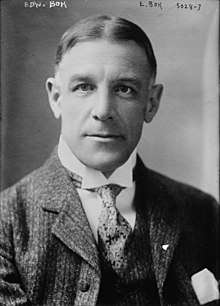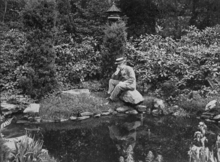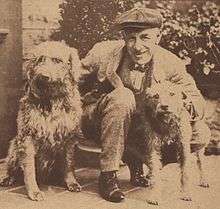Edward Bok
Edward William Bok (born Eduard Willem Gerard Cesar Hidde Bok[1]) (October 9, 1863 – January 9, 1930)[1] was a Dutch-born American editor and Pulitzer Prize-winning author. He was editor of the Ladies' Home Journal for 30 years (1889-1919). Bok is credited with coining the term living room as the name for a room of a house that had commonly been called the parlor or drawing room. He also created Bok Tower Gardens in central Florida.
Edward Bok | |
|---|---|
 Bok circa 1918 | |
| Born | Eduard Willem Gerard Cesar Hidde Bok October 9, 1863 Den Helder, Netherlands |
| Died | January 9, 1930 (aged 66) |
| Occupation | Editor and author |
| Nationality | American |
| Notable works | Successward, The Young Man in Business, The Young Man & The Church |
| Notable awards | Pulitzer Prize |
| Spouse | Mary Louise Curtis |
Life and career
Bok was born in Den Helder, Netherlands. At the age of six, he immigrated to Brooklyn, New York. In Brooklyn he washed the windows of a bakery shop after school to help support his family. His people were so poor that in addition he used to go out in the street with a basket every day and collect stray bits of coal that had fallen in the gutter where the coal wagons had delivered fuel.[2]
In 1882 Edward Bok began work with Henry Holt and Company. In 1884 he became involved with Charles Scribner's Sons, where he eventually became its advertising manager. From 1884 until 1887 Bok was the editor of The Brooklyn Magazine, and in 1886 he founded the Bok Syndicate Press.
After moving to Philadelphia in 1889, he obtained the editorship of Ladies Home Journal when its founder and editor Louisa Knapp Curtis stepped down to a less intense role at the popular, nationally circulated publication. It was published by Cyrus Curtis, who had an established publishing empire that included many newspapers and magazines.
In 1896 Bok married Mary L. Curtis, the daughter of Louisa and Cyrus Curtis.[3] She shared her family's interest in music, cultural activities, and philanthropy and was very active in social circles. Shortly before his marriage, he published an advice book for young men. He noted among other things, that "A man who truly loves his mother, wife, sister or sweetheart never tells a story which lowers her sex in the eyes of others."[4] During his editorship, the Journal became the first magazine in the world to have one million subscribers and it became very influential among readers by featuring informative and progressive ideas in its articles.[5] The magazine focused upon the social issues of the day. When Bok's autobiography, The Americanization of Edward Bok, appeared in 1920, he reviewed it with an interest based on long acquaintance with the magazine. Mencken observed that Bok showed an irrepressible interest in things artistic:
When he looked at the houses in which his subscribers lived, their drab hideousness made him sick. When he went inside and contemplated the lambrequins, the gilded cattails, the Rogers groups, the wax fruit under glass domes, the emblazoned seashells from Asbury Park, the family Bible on the marble-topped center-table, the crayon enlargements of Uncle Richard and Aunt Sue, the square pianos, the Brussels carpets, the grained woodwork—when his eyes alighted upon such things, his soul revolted, and at once his moral enthusiasm incited him to attempt a reform. The result was a long series of Ladies' Home Journal crusades against the hideousness of the national scene – in domestic architecture, in house furnishing, in dress, in town buildings, in advertising. Bok flung himself headlong into his campaigns, and practically every one of them succeeded. ... If there were gratitude in the land, there would be a monument to him in every town in the Republic. He has been, aesthetically, probably the most useful citizen that ever breathed its muggy air.[6]
The Journal also became the first magazine to refuse patent medicine advertisements.[7] In 1919, after thirty years at the journal, Bok retired.
In 1923 Bok proposed the American Peace Award.[8]

In 1924 Mary Louise Bok founded the Curtis Institute of Music in Philadelphia, which she dedicated to her father, Cyrus Curtis, and in 1927, the Boks embarked upon the construction of Bok Tower Gardens, near their winter home in Mountain Lake Estates, Lake Wales, Florida, which was dedicated on February 1, 1929, by the president of the United States, Calvin Coolidge. Bok Tower is sometimes called a sanctuary and is listed on the National Register of Historic Places as a National Historic Landmark. Bok is used as an example in Dale Carnegie's How to Win Friends and Influence People.[10]
Bok died on January 9, 1930, in Lake Wales, Florida, within sight of his beloved Singing Tower.[11] Two of his grandsons are Derek Bok and Gordon Bok.
Bok and American domestic architecture

In 1895, Bok began publishing in Ladies Home Journal plans for building houses which were affordable for the American middle class – from $1,500 to $5,000 – and made full specifications with regional prices available by mail for $5. Later, Bok and the Journal became a major force in promoting the "bungalow", a style of residence which derived from India. Plans for these houses cost as little as a dollar, and the 1 1⁄2-story dwelling, some as small as 800 square feet, soon became a dominant form of new domestic architecture in the country.[12]
Some architects complained that by making building plans available on a mass basis, Bok was usurping their prerogatives, and some, such as Stanford White openly discouraged him – although White later came around, writing
I believe that Edward Bok has more completely influenced American domestic architecture for the better than any man in this generation. When he began ... I refused to cooperate with him. If Bok would come to me now, I would not only make plans for him, but I would waive my fee for them in retribution for my early mistake.[12]
Bok is credited with coining the term living room as the name for room of a house that was commonly called a parlor or drawing room. This room had traditionally been used only on Sundays or for formal occasions such as the displaying of deceased family members before burial; it was the buffer zone between the public sphere and the private one of the rest of the house. Bok believed it was foolish to create an expensively furnished room that was rarely used, and promoted the new name to encourage families to use the room in their daily lives. He wrote, "We have what is called a 'drawing room'. Just whom or what it 'draws' I have never been able to see unless it draws attention to too much money and no taste ..." [13]
Bok's overall concern was to preserve his socially conservative vision of the ideal American household, with the wife as homemaker and child-rearer, and the children raised in a healthy, natural setting, close to the soil. To this end, he promoted the suburbs as the best place for well-balanced domestic life.[12]
Theodore Roosevelt said about Bok:
[He] is the only man I ever heard of who changed, for the better, the architecture of an entire nation, and he did it so quickly and effectively that we didn't know it was begun before it was finished.[12]
Opposition to women's rights
At the Ladies Home Journal, Bok authored more than twenty articles opposed to women's suffrage, women working outside the home, woman's clubs, and education for women. He solicited articles against women's rights from former presidents Theodore Roosevelt and Grover Cleveland. Bok viewed suffragettes as traitors to their sex, saying "there is no greater enemy of woman than woman herself."[14]
The Journal's wide reach among American middle-class women made Bok a key ally of the anti-suffrage movement.[14] Women's clubs attempted to organize a boycott of the Journal, for which Bok threatened them with legal action.[5]
Awards and honors
Bok's 1920 autobiography The Americanization of Edward Bok: The Autobiography of a Dutch Boy Fifty Years Later[5] won the Gold Medal of the Academy of Political and Social Science and the 1921 Pulitzer Prize for Biography or Autobiography.
The World War II Liberty ship SS Edward W. Bok was named in his honor.
Works
| Wikisource has original works written by or about: Edward Bok |
- Successward (1895) online
- The Young Man in Business (1895) online (Internet Archive)
- The Young Man & The Church (1896) (Google Books)
- Her Brother's Letters (1906)
- Why I Believe in Poverty (1915) online
- The Americanization of Edward Bok (1920) online free (Internet Archive, 1922 edition)
- A Dutch Boy Fifty Years After, edited by John Louis Haney (1921)
- Two Persons (1922) (Google Books)
- A Man from Maine (1923)
- Twice Thirty (1925)
- Dollars Only (1926) (Google Books preview)
- You: A Personal Message (1926)
- America Give Me a Chance (1926)
- Perhaps I Am (1928)
References
- "Edward Bok". Internet Accuracy Project. Retrieved January 22, 2011.
- Edward William Bok (1915). Why I Believe In Poverty. Curtis Publishing Company. pp. 6–9. LAGE-4427767.
- Hamersly, Lewis R. (1904). Who's who in Pennsylvania: A Biographical Dictionary of Contemporaries. L.R. Hamersly & Co. p. 66.
- P. 142 of Successward: A Young Man's Book for Young Men, by Edward William Bok, 1895
- "Bok, Edward. 1921. The Americanization of Edward Bok".
- Mencken, H. L. "The Incomparable Bok", Smart Set (January 1921), pp. 140-142. Review of The Americanization of Edward Bok (New York: Scribner, 1920)
- Bok, Edward William (1921). "Cleaning Up the Patent-Medicine and Other Evils". The Americanization of Edward Bok.
- "American Peace Award". Archived from the original on March 21, 2013.
- following P.450 of The Americanization of Edward Bok
- He appears in Part Two, Chapter 4 ("How to Become a Good Conversationalist").
- Gardens, Bok Tower. "Edward Bok - Author & Philanthropist - Bok Tower Gardens".
- Jackson, Kenneth T. (1985), Crabgrass Frontier: The Suburbanization of the United States, New York: Oxford University Press, ISBN 0-19-504983-7, p.186
- Anonymous. "The Living Room is Born". Ladies Home Journal. 125 (6): 12.
- Marshall, Susan E. (1997). Splintered Sisterhood. University of Wisconsin Press. p. 85, 104. ISBN 9780299154639.
Further reading
- Bogardus, Ralph F. "Tea Wars: Advertising Photography and Ideology in the Ladies' Home Journal in the 1890s." Prospects 16 (1991) pp: 297-322.
- Damon-Moore, Helen. Magazines for the millions: Gender and commerce in the Ladies' Home Journal and the Saturday Evening Post, 1880-1910 (SUNY Press, 1994)
- Kitch, Carolyn. "The American Woman Series: Gender and Class in The Ladies' Home Journal, 1897." Journalism & Mass Communication Quarterly 75.2 (1998): 243-262.
- Knight, Jan. "The Environmentalism of Edward Bok: The Ladies' Home Journal, the General Federation of Women's Clubs, and the Environment, 1901-09." Journalism History 29.4 (2004): 154.
- Krabbendam, Hans. The Model Man: A Life of Edward William Bok, 1863-1930 (Rodopi, 2001)
- Lewis, W. David. "Edward Bok: the editor as entrepreneur." Essays in Economic & Business History 20 (2012).
- Mott, Frank Luther. A history of American magazines. vol 4. 1885-1905 (Harvard UP, 1957) pp 536–555. covers Ladies Home Journal.
- Shi, David. " Edward Bok & The Simple Life" American Heritage (1984) 36#1 pp 100–109
- Snyder, Beth Dalia. "Confidence women: Constructing female culture and community in" Just Among Ourselves" and the Ladies' Home Journal." American Transcendental Quarterly 12#4 (1998): 311.
- Steinberg, Salme Harju. Reformer in the Marketplace: Edward W. Bok and the Ladies' Home Journal (Louisiana State University Press, 1979)
- Ward, Douglas B. "The Geography of the Ladies' Home Journal: An Analysis of a Magazine's Audience, 1911-55." journalism History 34.1 (2008): 2+
External links
| Wikimedia Commons has media related to Edward W. Bok. |
- Works by Edward Bok at Project Gutenberg
- Works by or about Edward Bok at Internet Archive
- Works by Edward Bok at LibriVox (public domain audiobooks)

- Edward Bok profile at Internet Accuracy Project
- Successward (1895) full text digitized online version from the University of Michigan Library MBooks.
